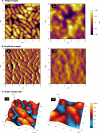Contribution of surface β-glucan polysaccharide to physicochemical and immunomodulatory properties of Propionibacterium freudenreichii
- PMID: 22247154
- PMCID: PMC3298172
- DOI: 10.1128/AEM.07027-11
Contribution of surface β-glucan polysaccharide to physicochemical and immunomodulatory properties of Propionibacterium freudenreichii
Abstract
Propionibacterium freudenreichii is a bacterial species found in Swiss-type cheeses and is also considered for its health properties. The main claimed effect is the bifidogenic property. Some strains were shown recently to display other interesting probiotic potentialities such as anti-inflammatory properties. About 30% of strains were shown to produce a surface exopolysaccharide (EPS) composed of (1→3,1→2)-β-D-glucan due to a single gene named gtfF. We hypothesized that functional properties of P. freudenreichii strains, including their anti-inflammatory properties, could be linked to the presence of β-glucan. To evaluate this hypothesis, gtfF genes of three β-glucan-producing strains were disrupted. These knockout (KO) mutants were complemented with a plasmid harboring gtfF (KO-C mutants). The absence of β-glucan in KO mutants was verified by immunological detection and transmission electron microscopy. We observed by atomic force microscopy that the absence of β-glucan in the KO mutant dramatically changed the cell's topography. The capacity to adhere to polystyrene surface was increased for the KO mutants compared to wild-type (WT) strains. Anti-inflammatory properties of WT strains and mutants were analyzed by stimulation of human peripheral blood mononuclear cells (PBMCs). A significant increase of the anti-inflammatory interleukin-10 cytokine production by PBMCs was measured in the KO mutants compared to WT strains. For one strain, the role of β-glucan in mice gut persistence was assessed, and no significant difference was observed between the WT strain and its KO mutant. Thus, β-glucan appears to partly hide the anti-inflammatory properties of P. freudenreichii; which is an important result for the selection of probiotic strains.
Figures





 , P ≤ 0.01;
, P ≤ 0.01; 

 , P ≤ 0.001).
, P ≤ 0.001).
 , P ≤ 0.05;
, P ≤ 0.05; 
 , P ≤ 0.01;
, P ≤ 0.01; 

 , P ≤ 0.001.
, P ≤ 0.001.
Similar articles
-
Correlation of the capsular phenotype in Propionibacterium freudenreichii with the level of expression of gtf, a unique polysaccharide synthase-encoding gene.Appl Environ Microbiol. 2010 May;76(9):2740-6. doi: 10.1128/AEM.02591-09. Epub 2010 Mar 12. Appl Environ Microbiol. 2010. PMID: 20228100 Free PMC article.
-
Promising immunomodulatory effects of selected strains of dairy propionibacteria as evidenced in vitro and in vivo.Appl Environ Microbiol. 2010 Dec;76(24):8259-64. doi: 10.1128/AEM.01976-10. Epub 2010 Oct 22. Appl Environ Microbiol. 2010. PMID: 20971874 Free PMC article.
-
Capsular exopolysaccharide biosynthesis gene of Propionibacterium freudenreichii subsp. shermanii.Int J Food Microbiol. 2008 Jul 31;125(3):252-8. doi: 10.1016/j.ijfoodmicro.2008.04.006. Epub 2008 Apr 22. Int J Food Microbiol. 2008. PMID: 18524407
-
Improving the drying of Propionibacterium freudenreichii starter cultures.Appl Microbiol Biotechnol. 2021 May;105(9):3485-3494. doi: 10.1007/s00253-021-11273-3. Epub 2021 Apr 22. Appl Microbiol Biotechnol. 2021. PMID: 33885925 Review.
-
New insights into physiology and metabolism of Propionibacterium freudenreichii.Int J Food Microbiol. 2011 Sep 1;149(1):19-27. doi: 10.1016/j.ijfoodmicro.2011.04.026. Epub 2011 May 8. Int J Food Microbiol. 2011. PMID: 21620505 Review.
Cited by
-
The secreted esterase of Propionibacterium freudenreichii has a major role in cheese lipolysis.Appl Environ Microbiol. 2014 Jan;80(2):751-6. doi: 10.1128/AEM.03640-13. Epub 2013 Nov 15. Appl Environ Microbiol. 2014. PMID: 24242250 Free PMC article.
-
A Unique Enhancement of Propionibacterium freudenreichii's Ability to Remove Pb(II) from Aqueous Solution by Tween 80 Treatment.Int J Mol Sci. 2022 Aug 16;23(16):9207. doi: 10.3390/ijms23169207. Int J Mol Sci. 2022. PMID: 36012472 Free PMC article.
-
β-glucan in the lymph nodes in sarcoidosis and in Kveim-Siltzbach test reagent.Sarcoidosis Vasc Diffuse Lung Dis. 2017;34(2):130-135. doi: 10.36141/svdld.v34i2.5844. Epub 2017 Apr 28. Sarcoidosis Vasc Diffuse Lung Dis. 2017. PMID: 32476834 Free PMC article.
-
Intrinsic immunomodulatory effects of low-digestible carbohydrates selectively extend their anti-inflammatory prebiotic potentials.Biomed Res Int. 2015;2015:162398. doi: 10.1155/2015/162398. Epub 2015 Apr 21. Biomed Res Int. 2015. PMID: 25977916 Free PMC article.
-
Identification of proteins involved in the anti-inflammatory properties of Propionibacterium freudenreichii by means of a multi-strain study.Sci Rep. 2017 Apr 13;7:46409. doi: 10.1038/srep46409. Sci Rep. 2017. PMID: 28406170 Free PMC article.
References
-
- Allen PZ, Bowen WH. 1988. Immunochemical studies on pneumococcal type 37 capsular polysaccharide. Mol. Immunol. 25:1011–1017 - PubMed
-
- Alp G, Aslim B, Suludere Z, Akca G. 2010. The role of hemagglutination and effect of exopolysaccharide production on bifidobacteria adhesion to Caco-2 cells in vitro. Microbiol. Immunol. 54:658–665 - PubMed
-
- Araujo R, Rodrigues AG, Pina-Vaz C. 2004. A fast, practical and reproducible procedure for the standardization of the cell density of an Aspergillus suspension. J. Med. Microbiol. 53:783–786 - PubMed
-
- Bolshakova AV, et al. 2001. Comparative studies of bacteria with an atomic force microscopy operating in different modes. Ultramicroscopy 86:121–128 - PubMed
-
- Bouglé D, Roland N, Lebeurrier F, Arhan P. 1999. Effect of propionibacteria supplementation on fecal bifidobacteria and segmental colonic transit time in healthy human subjects. Scand. J. Gastroenterol. 34:144–148 - PubMed
Publication types
MeSH terms
Substances
LinkOut - more resources
Full Text Sources
Other Literature Sources
Research Materials

